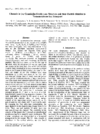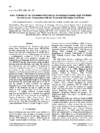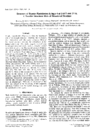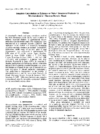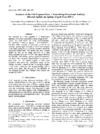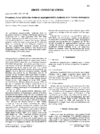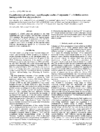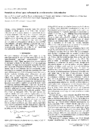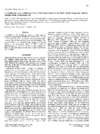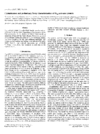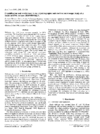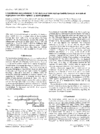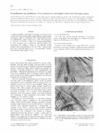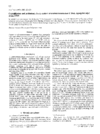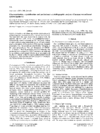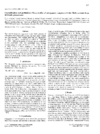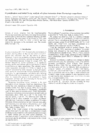issue contents
March 1997 issue

Cover illustration: View of interdomain interface of cell adhesion molecule VCAM-D1D2. The two hydrophobic patches (yellow from domain 1 and orange from domain 2) allow the domains to rock back and forth around the `pivot' residue Tyr89. The long C'E loop and FG loop seem to guide the movement. Courtesy of Jia-huai Wang.
research papers
High-resolution crystal structure of purine nucleoside phosphorylase has formed the foundation for a successful inhibitor design. A product of this design process, BCX-34, is currently undergoing clinical trials for treating T-cell lymphoma and T-cell leukemia. Resolving the ambiguity about the flexible loop covering the active site was the major achievement out of this refinement to high resolution.
The structure of the first enzyme:inhibitor covalent adduct of factor D with diisopropyl fluorophosphate to a resolution of 2.4 Å is described. Comparisons between the active sites of native factor D, the adduct of factor D with diisopropyl fluorophosphate and diisopropyl fluorophosphate-inhibited trypsin have provided fundamental insights which are currently being employed in drug design.
PDB reference: 1dfp
Download citation


Download citation


The X-ray structure of the cyclo-decapeptide, gramicidin S, is reported. it forms a twisted β-sheet, with two Phe residues in the D conformation to allow the necessary tight turns. Gramicidin S acts on cellular membranes, interacting with the lipid components, and the crystal symmetry generates a left-handed double spiral of molecules forming channels which could span the membrane.
The structure of the 154-amino-acid form of basic fibroblast growth factor, refined at 2.0 Å resolution, shows the same Kunitz-type fold as the N-terminus truncated 146-amino-acid form, and the eight-amino-acid extension does not seem to lower the flexibilty observed in the N-terminal residues of the truncated form. The structure included one phosphate ion and one molecule of mercaptoethanol.
PDB reference: 1bff
The X-ray crystal structure of human plasminogen kringle 4 at 1.68 Å and 277 K is presented. Most of the ten disordered residues form two patches on the surface of the protein. This localized disorder suggests that these residues may play a role in quaternary assembly and possibly part of an interface with other domains of proteins with kringle domains, such as plasminogen.
PDB reference: 1krn
A method is described that detects structural features (such as secondary structure elements) in electron-density maps.
The crystal structure of a Fab fragment directed against an important epitope of gp41 is described. The antigen-binding region is a pronounced groove and possible interactions with the peptide antigen are discussed.
PDB reference: 1nld
short communications
Crystals of the class IIb asparaginyl-tRNA synthetase of Thermus thermophilus, expressed in Escherichia coli, has been crystallized from PEG 6000 solutions. hydrophobic patches (yellow from domain 1 and orange from domain 2) allow the domains to rock back and forth around the `pivot', residue Tyr89. The long C'E loop and FG loop seem to guide the movement. Courtesy of Jia-huai Wang.
The cytochrome b562 from Erwinia chrysanthemi has been crystallized in a form suitable for high-resolution data collection. the structure solution of this enzyme will allow a comparison with that from E. coli and lead to a better undertstanding of the electron-transfer mechanism.
Isomorphous crystals of calgranulin C, an S100-like calcium-binding protein from pig granulocytes, were obtained in two different conditions. Crystals were characterized and a native data set collected to 2.6 Å resolution.
Real-space refinement, alternated with reciprocal-space refinement, leads to models of higher quality than when refined exclusively in reciprocal space, even when starting with a map based on typically poor isomorphous replacement phases.
Crystals of the FimC-FimH chaperone-adhesin pre-assembly complex from E. coli have been obtained. Data to 3.0 Å have been collected from a crystal frozen to T = 100 K.
Human GM2-activator protein, expressed in E. coli, has been crystallized yielding well ordered crystals for X-ray diffraction analysis. The crystal space group is P212121, a = 42.4, b = 39.8, c = 113.6 Å.
This paper describes the purification, crystallization and preliminary X-ray crystallographic and electron-microscopic characterization of a bacterial DNA helicase.
Two crystal forms of 3-carboxy-cis,cis-muconate lactonizing enzyme have been characterized. The study of both crystal forms is being pursued to determine the crystal structure of this enzyme.
Calystegia sepium agglutinin has been crystallized in an orthorhombic system with a dimer of identical 16 kDa subunits in the assymetric unit. A native data set to 2.0 Å resolution has been measured on a synchrotron source.
Crystallization and preliminary X-ray analysis of arabinofurano-sidase C from Aspergillus niger.
Crystals of human recombinant cyclooxygenase-2 in complex with a selective inhibitor have been grown and analyzed. Analysis of protein in solution correlates with the dimeric structure found in the crystal. inn
Nitrogenase from Klebsiella pneumoniae has been crystallized in two forms, one diffracting to 3.0 Å and the other to 1.5 Å. The X-ray analysis and MR solution is described.
The conditions for the crystallization of xylose isomerase from Thermotoga neapolitana and the initial X-ray analysis of the crystals are described.


 journal menu
journal menu













